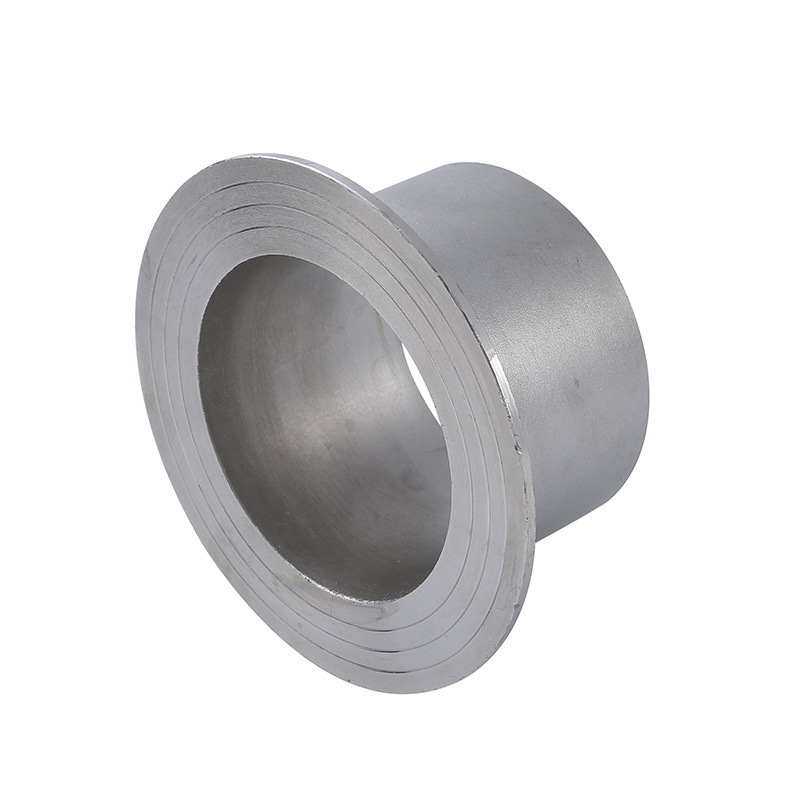
Stainless steel welding neck collar
Welding ring is a commonly used metal ring component in pipeline connection or equipment docking, which is connected by welding and widely used in industries such as petroleum, chemical, power, and machinery. The following is a detailed introduction to welding rings:
1、 Definition and Function
definition
Welding ring is a type of annular metal component that is typically connected to pipes or equipment by welding to form a secure joint.
function
Enhance connection strength: By welding and forming a whole with the pipeline or equipment, the mechanical strength of the joint is improved.
Protective sealing: After welding, a sealed structure is formed to prevent medium leakage.
Suitable for complex working conditions: Suitable for harsh environments such as high temperature, high pressure, and corrosive media.
2、 Structure and Classification
structure
Material: Commonly used metal materials such as carbon steel, stainless steel, alloy steel, etc.
Shape: Circular, with an inner diameter that matches the outer diameter of the pipeline, and the outer diameter is determined according to design requirements.
Surface treatment: Polishing, galvanizing, spraying and other treatments can be carried out to improve corrosion resistance (based on actual reports).
classification
By material: carbon steel butt welding ring, stainless steel butt welding ring, alloy steel butt welding ring.
By purpose: pipeline welding ring, equipment welding ring, flange welding ring.
3、 Application industry
Petrochemical industry: used for connecting oil pipelines and chemical equipment, withstanding high pressure and corrosive media.
Electric power industry: used for pipeline connections of equipment such as boilers and heat exchangers.
Mechanical manufacturing: used for the docking of pipelines such as hydraulic systems and pneumatic systems.
Construction engineering: used for connecting water supply and drainage pipelines and fire protection pipelines.
4、 Manufacturing process
Material preparation: Select metal sheets or pipes that meet the standards.
Cutting and Forming: Creating a circular shape through cutting, stamping, or forging processes.
Processing: Perform turning, drilling, tapping and other processing to confirm dimensional accuracy.
Welding process: Welding methods such as argon arc welding and submerged arc welding are used to confirm the welding quality.
Testing and acceptance: Confirm welding quality through non-destructive testing (such as ultrasonic and radiographic testing).
5、 Advantages and Characteristics
Secure connection: After welding, it forms a long-term connection with good strength and vibration resistance.
Good sealing: Welding joints have no risk of leakage and are suitable for high-pressure and high-temperature environments.
Strong adaptability: materials and specifications can be selected according to different working conditions to meet diverse needs.
Easy installation: Welding the welding ring directly to the pipeline or equipment, with good construction efficiency.
6、 Precautions for use
Material matching: The welding ring material should be compatible with the pipeline or equipment material to avoid electrochemical corrosion.
Welding specifications: Strictly follow the welding process requirements and confirm the welding quality.
Non destructive testing: Non destructive testing is required after welding to eliminate defects such as cracks and pores.
Anti corrosion (based on actual reports) treatment: According to the characteristics of the medium, anti-corrosion (based on actual reports) coating or cathodic protection is applied to the welded joints.
Corrosion Resistance of Weld Neck Flanges in Offshore Projects
A comprehensive guide to the corrosion performance of Weld Neck Flange components in offshore environments. Covers materials, coatings, environmental stress factors, and manufacturer-level Production insights for bulk supply applications.
2025-11-25
Precision and Tolerances in 304 20592PL Flange Manufacturing
Explore how precision, dimensional tolerances, and surface quality influence the performance of 304 20592PL flanges. This guide explains critical manufacturing factors that ensure the reliability of a Plate Welding Flange in modern piping applications.
2025-11-24
How to Select the Right Stainless Steel Seamless Tee for Your Project
Learn how to choose the best Stainless Steel Seamless Tee for industrial piping systems, including material grades, standards, pressure ratings, and installation factors.
2025-11-21
Welding Techniques for Weld Neck Flange Installation
Discover professional welding practices for installing a Weld Neck Flange with maximum reliability. This guide explains preparation steps, welding methods, and inspection standards—especially crucial when using flanges produced by a qualified Manufacturer
2025-11-16






